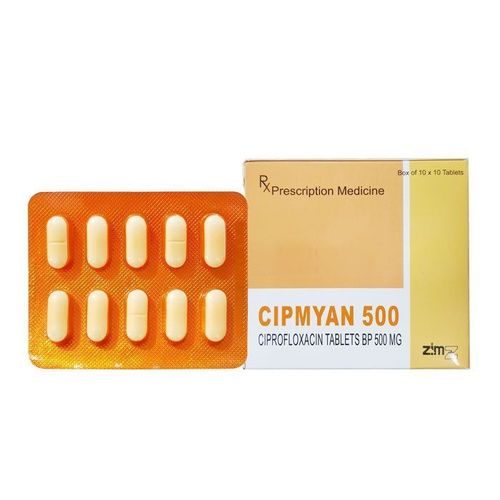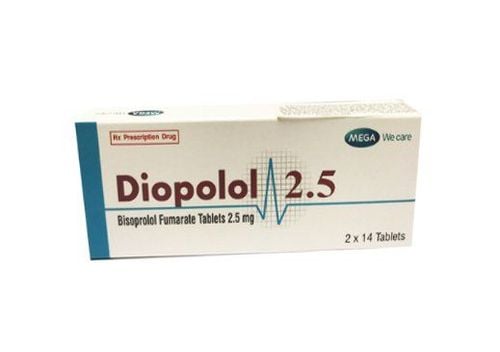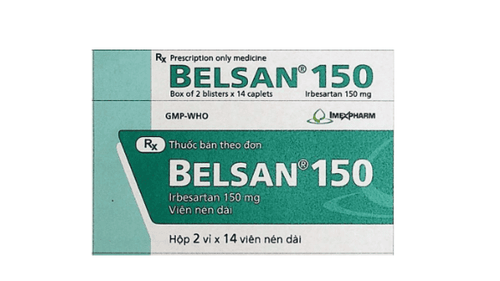This is an automatically translated article.
Carvesyl belongs to the group of cardiovascular drugs with the main ingredient being Carvedilol 6.25mg and other excipients. So what does Carvesyl do?
1. What does Carvesyl do?
Carvesyl is used in the treatment of:
Treatment of moderate to severe congestive heart failure Primary hypertension. Treatment of chronic stable angina attacks. On the other hand, the drug is contraindicated in the following cases: Hypersensitivity to the drug; Heart failure grade II or III; Cardiogenic shock, too slow heart rate, asthma, severe liver failure.
2. Dosage - How to take Carvesyl
2.1. How to take Carvesyl is to be taken orally with water. In patients with heart failure, Carvesyl should be used with food to slow absorption and reduce the risk of orthostatic hypotension.
2.2. Dosage Treatment of primary hypertension:
Carvedilol can be used to treat high blood pressure alone or in combination with other antihypertensive agents, especially in combination with thiazide diuretics. The maximum recommended dose is 25mg Carvedilol once, and 50mg Carvedilol/day. Adults: Initially 12.5 mg Carvedilol/time/day for the first two days. Then, 25mg Carvedilol x 1 time/day or starting with 6.25mg Carvedilolx 2 times/day for 1-2 weeks, then 12mg Carvedilol x 2 times/day. If necessary, increase the dose of Carvedilol slowly, at least two weeks apart. Elderly: Initially 12.5 mg Carvedilol x 1 time / day. However, if there is no response, the dose of Carvedilol can be increased gradually at least two weeks apart. Treatment of chronic stable angina:
Carvesyl is recommended twice a day. Adults: Initially 12.5 mg Carvedilol x 2 times/day for two days. Then increase to 25 mg Carvedilol twice daily. If necessary, increase the dose of Carvedilol at least two weeks apart. Maximum dose of 50 mg Carvedilol, used 2 times / day. Elderly: Initiate 12.5 mg Carvedioldilol twice daily for the first two days. Thereafter, increase the dose to a maximum of 25 mg Carvex twice daily. Heart failure:
Initially 3.125mg Carvedilol x 2 times/day for 2 weeks. If this dose is tolerated, the dose can be increased gradually to 6.25 mg Carvedilol twice daily at least two weeks apart. The dose of Carvesyl may be increased slowly over a period of two weeks or less. The dose of Carvesyl was increased to the maximum tolerated dose. The maximum recommended dose is 25 mg Carvedilol twice daily for patients weighing less than 85 kg or severe heart failure, and 50 mg Carvedilol twice daily for patients weighing more than 85 kg, provided that the Non-severe heart failure Renal failure: No dose adjustment of Carvedilol is required.
Hepatic impairment : Carvedilol dose adjustment is required.
Children < 18 years old: Carvesyl is not recommended.
Elderly: Carvesyl should be used with caution, especially in patients with coronary artery disease, the process of discontinuing carvedilol should be gradually reduced.
3. Carvesyl drug interactions
The following are some of the reported interactions with Carvesyl:
Care should be taken when taking Carvesyl with digoxin, verapamil, rifampicin, warfarin, clonidine. Dihydropyridine in combination with carvedilol can cause heart failure and hypotension, patients should be closely monitored when used in combination with these two drugs. Nitrate and carvedilol increase the antihypertensive effect. Cardiac glycosides in combination with carvedilol may increase digoxin concentrations when taken at the same time. T May enhance the effect of other antihypertensive drugs such as barbiturates, phenothiazines, vasodilators, tricyclic antidepressants and alcohol when used concomitantly with Carvedilol. Cyclosporin co-administered with carvedilol has reported a modest increase in cyclosporin concentrations after initiation of carvedilol therapy in 21 renal transplant patients with chronic rejection. The hypoglycemic effect of oral antidiabetic agents, including insulin, may be enhanced when co-administered with carvedilol. In case of co-administration of carvedilol and clonidine, if the drug is to be discontinued, carvedilol should be discontinued a few days before discontinuing clonidine. Care should be taken in the case of co-administration of Carvesyl with synergistic anesthetics, slowing the heart rate and lowering blood pressure. Concomitant use of NSAIDs, corticosteroids, and estrogens with carvedilol may reduce the antihypertensive effect of carvedilol by causing salt and water retention. Cytochrome P450 enzyme inhibitors (Rifampicin, haloperidol, barbiturates, ketoconazole, fluoxetin, verapamil, cimetidine, erythromycin) require close monitoring during concomitant treatment with carvedilol. Rifampicin in combination with carvedilol reduces the plasma concentration of carvedilol by about 70%. Cimetidine in combination with carvedilol can increase AUC by about 30% but not change Cmax. Alpha and beta sympathomimetic drugs combined with carvedilol are associated with a risk of high blood pressure and excessive bradycardia. Ergotamine combined with carvedilol increases vasoconstriction. Increases neuromuscular blockade of neuromuscular blocking agents when combined with carvedilol. To ensure safety when using Carvesyl, patients should inform their doctor about other diseases they have and other drugs they are using, so that they can have a reasonable medication direction to avoid interactions. medication may occur.
4. What are the side effects of Carvesyl?
During the use of Carvesyl, patients may experience some side effects, which are mostly temporary in nature and go away after a while.
Common:
Dizziness, headache Whole body: Muscle pain, headache, fatigue, shortness of breath. Circulatory: Postural hypotension, dizziness. Gastrointestinal: Nausea. Uncommon: Bradycardia, diarrhea, abdominal pain
Rare:
Blood: Leukopenia and thrombocytopenia. Circulation: Poor regulation of the peripheral circulation, interrupted. Central nervous system: Paresthesia, depression, sleep disturbance. Digestion: Vomiting, constipation. Skin: Urticaria, pruritus, psoriasis Liver: Increased liver transaminases. Eyes: Reduce tear secretion, irritation. Respiratory: Nasal congestion. Patients should inform their doctor or pharmacist of any side effects they experience while using Carvesyl.
5. Pay attention to precautions when using Carvesyl treatment
The following cases need to be cautious when using Carvesyl for treatment:
Carvesyl should be used with caution in patients with congestive heart failure treated with angiotensin-converting enzyme inhibitors, digitalis, diuretics because of conduction. atrioventricular may be slowed down. Patients with diabetes without or difficult to control blood sugar because when using Carvesyl drug can mask the symptoms of hypoglycemia. If the patient develops liver damage, treatment with Carvesyl should be discontinued. Patients with hyperthyroidism, peripheral vascular disease and patients with anesthesia should be cautious when taking Carvesyl. In patients with intolerance to other antihypertensive drugs, very small doses of Carvesyl can be used with caution in patients with bronchospasm. During treatment, avoid abrupt discontinuation of Carvesyl, the drug must be discontinued at intervals of 1-2 weeks. Concomitant administration of Carvesyl with inhaled anesthetics considers the risk of cardiac arrhythmias. Carvesyl should be used with caution when co-administering carvedilol with class I antiarrhythmic drugs. Carvesyl is not recommended for use in children because safety and efficacy have not been established in this population. Carvedilol has been reported to cause harm to the fetus. Therefore, Carvesyl should only be used during pregnancy if the potential benefit outweighs the potential risk. Do not take Carvesyl during the third trimester of pregnancy or near the time of delivery. Undesirable effects on the fetus have been reported such as: Decrease in blood pressure, bradycardia, respiratory depression, decrease in blood glucose - blood, hypothermia in the neonate, possibly during pregnancy the mother used. carvedilol. Carvedilol may be excreted in human milk; however, there is no risk of undesirable effects on the nursing infant. Carvedilol has no influence on the ability to drive or use machines. However, unwanted side effects such as: Dizziness, headache, low blood pressure can affect. Therefore, caution should be exercised when using Carvesyl in this case. Note: Carvesyl is prescribed by a doctor, patients do not arbitrarily use Carvesyl without indication.













